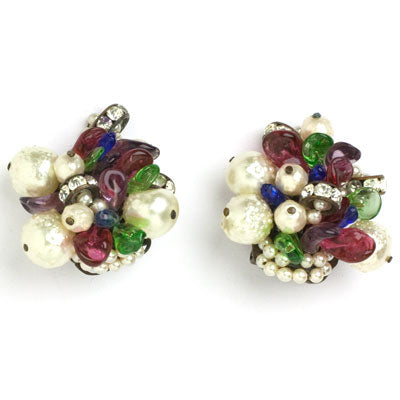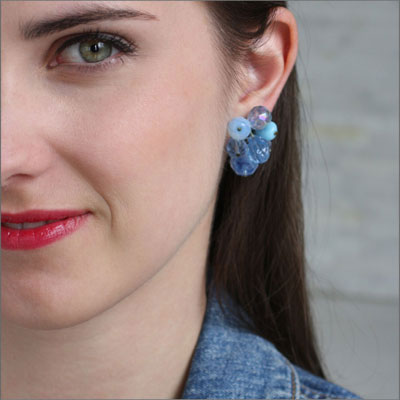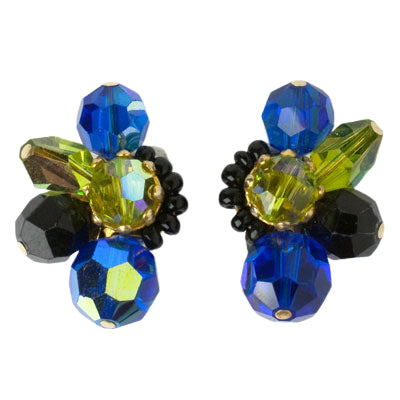
If you enjoy period TV series and movies as much as I do, I’m sure you find the costumes and sets as entertaining as the stories. The Marvelous Mrs. Maisel, set in the late-1950s, provides eye-candy for jewelry lovers like me. Because the show is streaming, we can experience the era and admire the jewels as often as we wish. And with each viewing, we can imagine how to wear them in a modern way. Earrings, in particular, can easily add a touch of Fifties glamour to a casual outfit and express your personal style. Here are some great examples of 1950s beaded earrings, a type seen often in the show. All are by some of the finest makers of the decade.
Miriam Haskell
Well-respected for high-quality materials and designs, this firm continues to make jewelry that is always special. Frank Hess, chief designer from 1926-1960, is known for his use of complimentary colors and textures, layers, and natural themes (Gordon & Pamfiloff 109-110).
The photo above shows rows of white glass beads and disks held together with rondelles and gold-tone metal. The construction allows the components to move. What a distinctive pair of 1950s beaded earrings! Although I’ve always thought they were fun, I saw them in an entirely new, bright and glamorous light when they were chosen to walk the runway at a recent fashion show.
Here are two more examples from this great maker.
 |
 |
L: Beaded Flower Earrings by Miriam Haskell R: Diamanté & Bead Flower Earrings by Miriam Haskell
On the left, a flower is formed with a base of citrine-glass stones that alternate with petals of textured silver-tone metal. A large, faceted citrine-glass bead tops this three-dimensional design. The flowers on the right are simpler but no less lovely. At the center is a large, faceted diamanté, which is surrounded by petals of tiny clear- and grey-glass bi-color beads wired together. See how beautifully this pair compliments a basic black-and-white shirt.
Louis Rousselet
Pearls were a '50s jewelry wardrobe staple – a simple strand for the neck and a single stud for the ear. Some makers went further. Louis Rousselet, the premier producer of faux pearls and colorful beads in the first half of the 20th century, is one. His jewelry is coveted and proudly worn by vintage jewelry enthusiasts today. Looking at these two examples, you can see why.
 |
 |
L: Pearl & Glass Flower Earrings R: Pearl, Gemstone & Rondell Earrings
The ear clips on the left feature hand-wound-glass flowers and leaves sitting on a base of tiny faux pearls. [Please note: Two years after I posted this article, I confirmed that these components were made by Rousselet, but the earrings were designed and manufactured by another creator of costume jewelry for haute couture.]
The pair on the right has round pearls of different sizes interspersed with hand-wound-glass leaves in gemstone colors (ruby, sapphire, emerald and amethyst). Diamanté rondelles add a touch of sparkle. Both creations are complex, hand-made and very three-dimensional.
Hattie Carnegie
I think 1950s beaded jewelry from the fashion house of Hattie Carnegie is particularly innovative and distinctive.
 |
 |
L: Blue Bead Earrings by Hattie Carnegie R: Sapphire, Onyx & Citrine Bead Earrings by Hattie Carnegie
On the left is a pair of ear clips with clusters of blue beads. But the jewels are more than simple beads: what makes these earrings stand out is the diversity of shapes, tones, sizes and finishes used. Some are coated with Aurora Borealis, which adds iridescence. See how easily my favorite model wears these jewels with a denim jacket.
The earrings on the right are a similar design but have an entirely different look. The use of color, an essential in the 1950s, makes them special. Blue, black and yellow-green beads in different shapes and sizes are iridescent. This unusual and bold color combination would also add a touch of chic to a casual outfit. Both pairs were designed to frame the face – the left and right earrings are different.
Alice Caviness
Jewelry sold by Alice Caviness in the 1950s is unique and imaginative. These two examples incorporate colorful beads with other types of components.
 |
 |
L: Citrine, Golden Topaz Earrings by Alice Caviness R: Alice Caviness Black & White Bead Earrings
The pair on the left features layers of citrine- and golden-topaz-glass beads along with aurora borealis diamantés, mother-of-pearl disks, and textured brass leaves. The components are wired onto a brass mesh back, which is mounted on a filigree scalloped-edged disk. Colorful and three-dimensional, these ear clips are fun!
On the right is a pair in a starburst or atomic motif, so popular in the 1950s. The beads are bi-color glass in black and clear. Some have caps of silver-tone filigree, while other caps are solid metal. This three-dimensional design looked glamorous on the model who wore them on a recent fashion show runway with a 1930s onyx bracelet – an unexpected, yet very clever combination!
A Common Question
One of the benefits of ear clips is that they can be worn by everyone. Women with pierced ears often ask if the clip-back fastener can be converted to a post. The answer is ‘no’. In general, the size of the clip is an integral part of the earring's structure and is needed to properly support its weight. When you purchase a pair of this type of earring, you’ll receive a pair of clip cushions for added comfort.
For More 1950s Beaded Earrings
See the boutique’s 1950s Jewelry collection, which features all types of jewelry from that decade by these featured makers and others.
Quoted Print Source
Gordon, Cathy and Sheila Pamfiloff. Miriam Haskell Jewelry. Revised 2nd edition. Schiffer Publishing, 2009.

Leave a comment